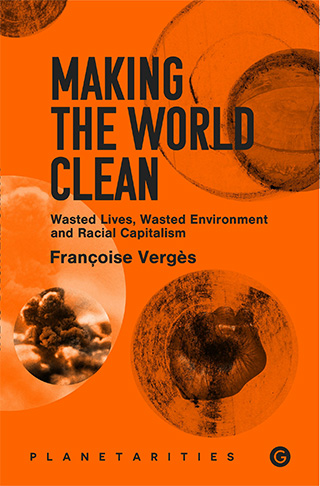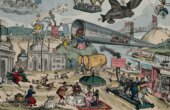Olfactory Racism

In his 1994 book “The Foul and the Fragrant,” French historian Alain Corbin described how, from the 1750s onward, a stigmatization of groups associated with strong smells was part of a “perceptual revolution” that encouraged a growing intolerance of odors that increased in the 19th century among the bourgeoisie. The bourgeoisie, he explains, associated them with the crowd and the people; it was how hygienists began the enterprise of deodorization.

The poor stank like death, like sin, the bourgeois said. To stop the sources of foul smells, roads were paved, swamps drained, and garbage dumps located away from bourgeois neighborhoods, leading progressively, according to Corbin, to “olfactory silence,” but only in certain parts of the city. Corbin left aside the racial ideology of smell. The racial making of an odorless world and its connection to conceptions of washing and cleaning described how in Europe, Jews, Roma, Irish, workers, and peasants were said to have distinctive smells that situated them outside of a civilized group. Food and hygiene became markers along a racial hierarchy of smells, which consolidated as colonialism expanded. “At the beginning of the eighteenth-century [sic] Native Americans were described as sweet but by the end of the period, they were said to project ‘outward stench,’” writes the historian William Tullett. “By the early eighteenth century the cause of the racial perceived stink of the Jews, the ‘foetor judaicus,’ was now seen as the product of distinctive hygiene and diet rather than a curse from god.”
The poor stank like death, like sin, the bourgeois said.
White supremacy drew a very detailed nomenclature connecting non-whites and foul odor and, by the 18th century, it made an association between the African’s dark skin and stench. Non-whites were situated along a scale of putridity and foul odor. Slavery and colonization were the matrix of the racist discourse linking non-whiteness, foul odor, and uncleanliness. Beauty was connected to an odorless white body that could then be perfumed, whereas non-white bodies were said to have an odor that could never be overcome, that no bath could erase.
An example of this is found in the letters and writings of Lady Anne Lindsay Barnard, a Scottish travel writer, artist, and socialite, from when she lived for five years in Africa with her husband, the colonial secretary of Cape Town, South Africa. In a 1799 letter to Melville, then secretary for war and the colonies in England, she complained that “one of the worse points of [female] slaves . . . is the dreadful smell which they leave behind them — a ‘fox is a rose to it’” and subsequently complains that she would rather slaves were not able to attend a ball since she did not “much like the smell” of their oil. Distinctions, based on pure fantasies, were made among Africans according to their smells.
In his natural history, the French naturalist Georges-Louis Leclerc, Comte de Buffon argued that “those of Guinea are extremely ugly, and have an insufferable stench” whilst “those of Sofala and Mosambique are handsome, and have no bad smell.” As historian Andrew Kettler has shown, “the African subject was defined as a scented object, appropriated as filthy to create levels of ownership through discourse that marked African peoples as unable to access spaces of Western modernity. Embodied cultural knowledge was potent enough to alter the biological function of the five senses to create a European olfactory consciousness made to sense the African other as foul.” The European nose became the arbiter of nice smells, imposing its perception of foul/smelly not only on non-white women and men but also on non-European fruits, spices, or ways of cooking. The gaze was not the only sense convoked to racialize; olfactory racism, as Kettler calls it, was as important in the formulation of racial ideas.
All throughout the 18th century, white supremacy perfected its discourse of race and odor, which had concrete consequences. By the 19th century, whites used dogs to track runaway slaves because they could supposedly detect “racial odor,” foreseeing the use of dogs by the Nazis to detect the “odor of dissent.” Ideas about odorous women, the lack of sensitivity to foul smells among the poor, and the peculiar odor of inferior races mutually reinforced racism. The racist trope of smell constructed a false history where whites and Europeans have always been odorless and clean.
The racist trope of smell constructed a false history where whites and Europeans have always been odorless and clean.
Yet, as Italian journalist and social theorist Marco d’Eramo reminds us, domestic running water — for toilets, cooking, personal hygiene, washing clothes and dishes — is a very recent and ephemeral phenomenon, dating back less than a century:
In 1940, 45 percent of households in the U.S. lacked complete plumbing; in 1950, only 44 percent of homes in Italy had either indoor or outdoor plumbing. In 1954, only 58 percent of houses in France had running water and only 26 percent had a toilet. In 1967, 25 percent of homes in England and Wales still lacked a bath or shower, an indoor toilet, a sink and hot- and cold-water taps. In Romania, 36 percent of the population lacked a flushing toilet solely for their household in 2012 (down to 22 percent in 2021).
In France, the modernization of bathrooms came with the end of the colonial war in Algeria, as scholar of urban and revolutionary history Kristin Ross shows in her 1996 book “Fast Cars, Clean Bodies: Decolonization and the Reordering of French Culture.”Ross draws a connection between torture and shampoo, between water in the bathtub and colonial war, between the new modernized hygienic France and the sale guerre across the sea. She describes a cartoon showing a “French paratrooper in camouflage bending over a sudsy bathtub, his hands submerged; a box of Pax laundry soap (‘extraordinaire pour la lessive!’) standing next to the tub — but a man’s feet stick out of the water; the bubbles aren’t suds, but rather the tortured man exhaling.” The year the Algerian revolution started, in 1954, only 17 percent of Parisians had a shower or bath in their dwellings, Ross reminds us.

The racist tropes around smelly Arabs and dirtiness were used to justify torture and murder. The war in Algeria and its presence in France was a cleansing operation: The French army burned forests, bombed with napalm, and forcibly relocated the Algerians into camps. As architect Samia Henni explains:
The construction of militarily controlled camps dubbed centres de regroupement (regrouping centers) in Algeria’s rural areas resulted from the creation of the forbidden zones — free fire zones — and engendered massive forced relocations of the Algerian population. Special military units called the Sections administratives spécialisées (Specialized Administrative Sections) supervised the evacuation of the forbidden zones, the regrouping of the Algerian population, the construction of temporary and permanent camps, the conversion of a number of permanent camps to villages, and monitored the daily life of Algerian civilians.
In his essay “Concerning Violence,” the anticolonial psychiatrist and political philosopher Frantz Fanon explained why the divide between the white and non-white town had to be clear and visible. The settlers’ town, he writes, “is a brightly lit town; the streets are covered with asphalt, and the garbage cans swallow all the leavings, unseen, unknown and hardly thought about . . . His feet are protected by strong shoes although the streets of his town are clean and even, with no holes or stones,” while the town belonging to the colonized people is “a world without spaciousness; men live there on top of each other, and their huts are built one on top of the other.” The settler’s town must be clean because it must project his own image, the one that is built on racism and white supremacy. His city is clean because non-white people have cleaned it, and garbage has been dumped in their neighborhood because of supposed natural white superiority. In the aftermath of French colonial wars against movements of national independence and as the French state was reorganizing itself along capitalist modernization ideology, the colonial discourse on the threat by natives to cleanliness and hygiene was imported into France.
If we look at Paris, the bourgeoisie has historically made every effort to delimit the white/clean city from the non-white/unclean neighborhoods. Transformations of the city, already undertaken at the beginning of the 19th century, accelerated a growing concern for cleanliness following the revolutions of 1830 and 1848. As Victor Considérant wrote in his influential work “Destinée sociale,” published in 1834, “Paris is an immense site of putrefaction, where misery, pestilence and disease work in concert, and where air and sunlight hardly penetrate. Paris is a bad place, where plants wither and perish, where six out of every seven children die in a year.” In the 1840s, French statesman Adolphe Thiers ordered the construction of city fortifications transforming Paris into a fortress, and Georges Eugène Haussmann, the official who made Paris the city it is still today, started to redraw the city in 1852.
The Paris Commune was a turning point, and a terrified bourgeoisie was intent on pushing away an international working class, which had the temerity to challenge its power and invent new ways to live. Later, the destruction of the fortifications was decided and completed in 1929 and replaced at the beginning of the 1930s by social housing. It was called the “zone,” inhabited by zonards (a deprecating term for someone from a deprived area) in their “insalubrious housing.” In 1956, the government decided to construct a périphérique that would separate Paris proper from the banlieues (outskirts). The zone was cleared, its inhabitants evicted, and the périphérique was inaugurated in 1973.
Olfactory racism remained alive in the postcolonial West. In an infamous 1991 speech, Jacques Chirac, then mayor of Paris and later French president, declared:
How do you expect the French worker who lives in the Goutte-d’or, where I was walking with Alain Juppé three or four days ago, who works with his wife and who, together, earn about 15,000 francs, to see a family with a father, three or four wives, and about twenty kids, on the landing next to his HLM, crammed together, earning 50,000 francs in social benefits, without of course working! [loud applause]. If you add to that the noise and the smell [loud laughter], well, the French worker on the landing, he goes crazy. He goes crazy. That’s the way it is. And you have to understand, if you were there, you would have the same reaction.
The group Zebda, based in Toulouse and created by sons of migrants from North Africa and French youth, answered in 1995 with a rap song reminding the French that those who “smell” had built their society:
Who built this road?
Who built this city?
And who doesn’t live here?
To those who complain about the noise
To those who condemn the smell
I introduce myself
My name is Larbi, Mamadou Juan and make way
Guido, Henri, Chino Ali I am not ice
A voice told me “Marathon” seeks the light
From the abyss I drew a fight “the good deal.”
Olfaction, which is “possibly our most primitive sense,” has been very useful in many jobs: medicine, cooking, gardening, taking care of animals, babies, the elderly. But racial capitalism has imposed a perfumed and deodorized world where some smells are found offensive.
The distinction between the open market with its smells of fish, fruit, meat, and piles of rotten vegetables and the odorless supermarket with its packaged fruits, vegetables, and meat, where even fresh fish has no smell, is made everywhere. In the Global South, tourists are warned that if the local market makes for great pictures, beware of the smell of the durian fruit or any other smell that assaults the Western nose, of fresh and dry fish, of raw meat, and certainly do not buy fruit there. Rather, go to the supermarket, whose brands (U.S., French, British) are familiar.
On the other hand, smells have been a source for marketing perfumes, deodorants, creams, and home or office ambiance smells. Olfactive branding is a new field based on neuroscience research on the link between smell and emotions, which has expanded the field of fabricated smells in a search for authenticity in fashion (the “authentic” smell of cotton or wool, for instance). Dawn Goldworm, cofounder and nose, or scent, director of the olfactive branding company 12.29, “uses the ‘visceral language of scent to transform brand-building’ in the actual buildings where clients reside (mostly through ventilation systems or standalone units).” Goldworm designed Nike’s signature scent, which she explains in a video “was inspired by, among other things, the smell of a rubber basketball sneaker as it scrapes across the court and a soccer cleat in grass and dirt.” She says her goal is to create “immediate and memorable connections between brands and consumers.” What this shows goes beyond perfumes and the ways people in different cultures like or dislike certain smells; it points to a manufactured world of scent.
The distinction between smells (odorless/foul) has had concrete consequences on the elemental by hindering access to water, by justifying massacres and murder, by denying public health, by segregating housing, and by considering the needs of women of color to be trivial. The notion of cleanliness of white bourgeois bodies and the cleanliness of their cities and of the planet they wish to inhabit must be analyzed along the axis of Global North and Global South, but also by looking at the ideology that ascribed cleaning that which is dirty to certain groups of people.
Françoise Vergès is currently Senior Fellow Researcher at the Sarah Parker Remond Centre for the Study of Race and Racialization, University College London. She writes books and articles on the afterlives of slavery and colonization, climate catastrophe and racial capitalocene, the impossible decolonization of the western museum, decolonial feminism, psychiatry, and the “post-museum.” She is the author of several books, including “Making the World Clean” (Goldsmiths Press), from which this article is excerpted.



